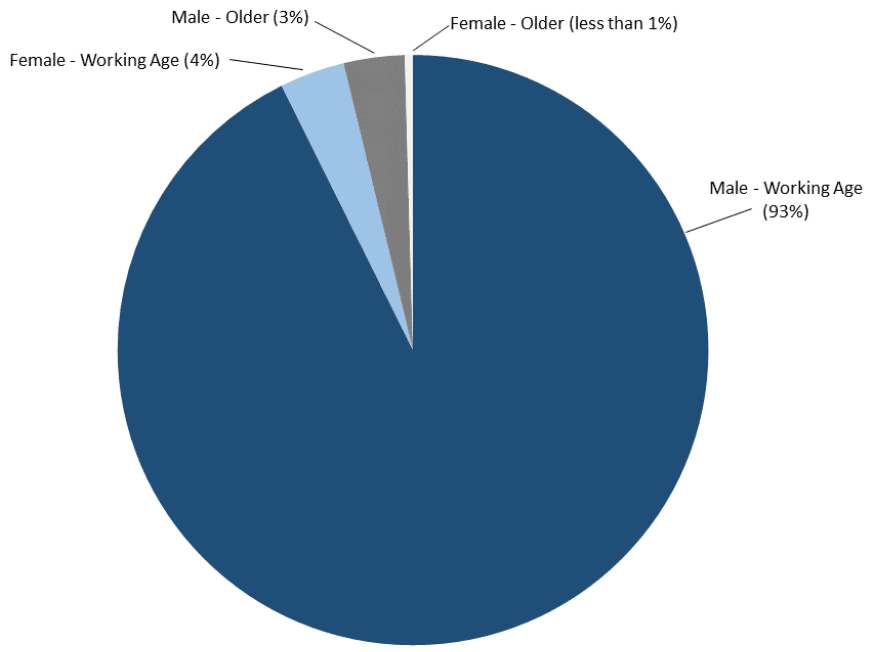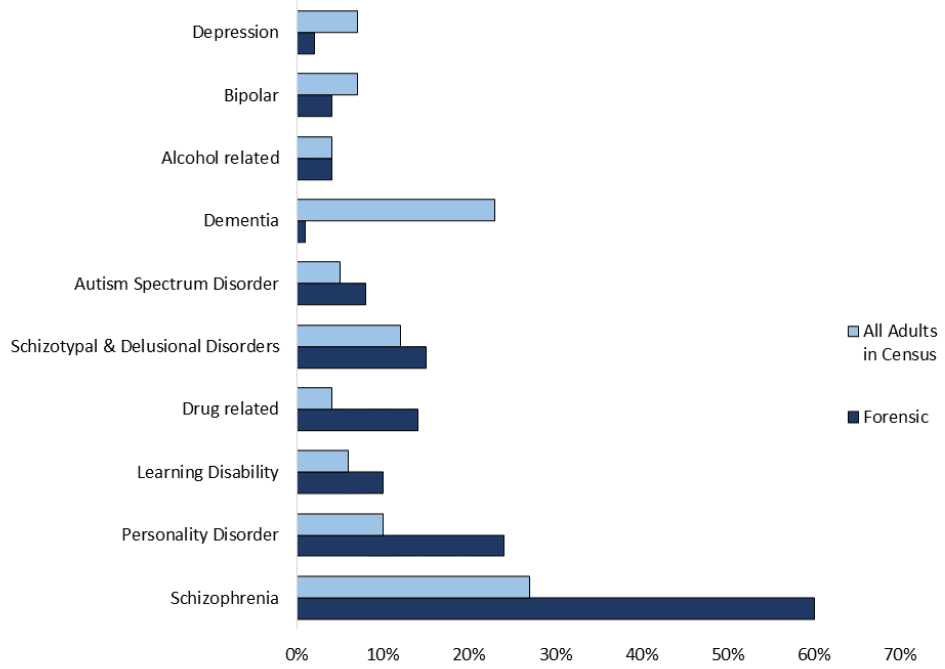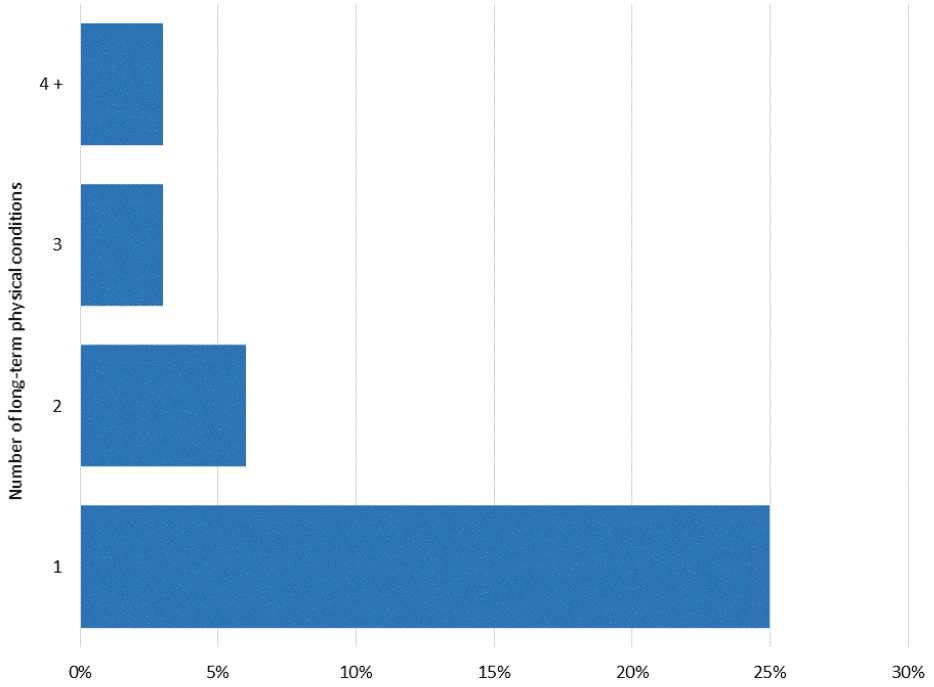Inpatient census 2022: parts one and two
Results of the sixth Mental Health & Learning Disability Inpatient Census and Out of Scotland NHS Placements Census, 2022.
6. Patients receiving Forensic Services (additional detail)
- 450 (16%) patients in the Census were receiving Forensic Services
- Patients receiving Forensic Services are mostly males of working age
- 5 out of 6 forensic patients were either Overweight or Obese as at the Census
Forensic psychiatry is a specialised branch of clinical psychiatry which relates to mentally disordered offenders and others with similar problems. For the purpose of the analysis contained in this section, forensic patients were identified if NHS Boards indicated “yes” to the following Census question: is the patient being managed primarily by forensic services?
There were 450 patients primarily managed by Forensic Services in the 2022 Census. This is a decrease on the 488 patients reported in 2019.
It should be noted that NHS Greater Glasgow & Clyde, NHS Lothian and NHS Tayside contain Forensic Regional Units which provide services to patients from other NHS Boards. NHS Fife also provide a low secure Learning Disability (Forensic) Regional Unit for the treatment of patients from other NHS boards. The State Hospital (a Special NHS Board), provides a National Service (including for Northern Ireland).
| NHS Board | 2014 | 2016 | 2017 | 2018 | 2019 | 2022 |
|---|---|---|---|---|---|---|
| NHS Ayrshire & Arran | c | c | 16 | 18 | 19 | 18 |
| NHS Borders | 0 | c | 0 | 0 | 0 | 0 |
| NHS Dumfries & Galloway | 0 | c | 0 | c | c | 0 |
| NHS Fife | 31 | 34 | 39 | 35 | 39 | 27 |
| NHS Forth Valley | 20 | c | c | c | c | 12 |
| NHS Grampian | 42 | 42 | 40 | 41 | 37 | 44 |
| NHS Greater Glasgow & Clyde | 128 | 122 | 119 | 123 | 119 | 117 |
| NHS Highland | c | c | c | c | c | 6 |
| NHS Lanarkshire | 19 | 15 | 20 | 25 | 28 | 25 |
| NHS Lothian | 65 | 47 | 56 | 51 | 72 | 41 |
| NHS Tayside | 65 | 55 | 64 | 62 | 49 | 47 |
| NHS Western Isles | 0 | 0 | 0 | 0 | 0 | 0 |
| State Hospital | 121 | 117 | 111 | 108 | 109 | 113 |
| Scotland | 507 | 458 | 484 | 475 | 488 | 450 |
* c - Suppressed due to small numbers
Age and Gender
The vast majority of patients receiving forensic services are working age males. Male patients made up 96% of all forensic services patients in the 2022 Census, seven percentage points higher than 2019. Only 4% of forensic patients are aged 65 and over.

Ward Type
Most forensic services patients were treated in a forensic ward, (369 patients, 82%), of which 52 were in a learning disability ward. A further 60 (13%) patients were in a rehabilitation (non addiction) ward, while 12 (3%) were in an intensive psychiatric care unit.
Ward Security Level
There were 135 (30%) patients receiving forensic services in a low security ward in the 2022 Census. A further 126 (28%) were in a medium security ward, while 113 (25%) were in a high security ward. This is a decrease from 22% patients in high security wards in 2019. Only 3% were in a general psychiatric ward, compared with 65% in all mental health, addiction or learning disability patients.
Specialty of Consultant
A total of 370 (82%) patients receiving forensic services were seen by a forensic psychiatrist. There were less than 1% of patients being seen by a consultant whose specialty was Psychiatry of Old Age.
Length of stay in hospital
Patients receiving forensic services tend to have longer average (median) lengths of stay. The average (median) time since admission at the 2022 Census for patients receiving forensic services was around 2 years and 9 months. This compares with non-forensic services patients who had an average (median) admission time of 3 months.
| Group | Average (median) number of days since admission | Approx. number of years / months |
|---|---|---|
| Forensic Services Patients | 1010 | 2 years, 9 months |
| Non-forensic Services Patients | 100 | 3 months |
Of the 450 patients receiving forensic services in the 2022 Census, 340 (76%) had been in hospital for over a year. Only 11 (2%) patients had been in hospital for less than two weeks.
| Banded days since admission | 2016 | 2017 | 2018 | 2019 | 2022 | |||||
|---|---|---|---|---|---|---|---|---|---|---|
| Less than 2 weeks | 10 | 2% | 13 | 3% | 13 | 3% | 17 | 3% | 11 | 2% |
| At least 2 weeks, less than 1 month | 10 | 2% | 15 | 3% | c | c | 10 | 2% | 6 | 1% |
| At least 1 month, less than 3 months | 23 | 5% | 36 | 7% | c | c | 21 | 4% | 34 | 8% |
| At least 3 months, less than 6 months | 49 | 11% | 34 | 7% | 43 | 9% | 33 | 7% | 23 | 5% |
| At least 6 months, less than 1 year | 45 | 10% | 58 | 12% | 43 | 9% | 37 | 8% | 36 | 8% |
| At least 1 year, less than 5 years | 202 | 44% | 203 | 42% | 226 | 48% | 234 | 48% | 195 | 43% |
| 5 years or more | 119 | 26% | 125 | 26% | 114 | 24% | 136 | 28% | 145 | 32% |
* c - Suppressed due to small numbers
Health and Wellbeing
Mental health morbidities
NHS Boards returned diagnosis codes (ICD-10) for any mental health condition for which patients in the 2022 Census had a diagnosis. Of the 450 patients receiving forensic services for whom diagnosis information was returned, 155 (36%) had 2 or more mental health conditions. This compares to 21% for all adult patients.
The most common condition for patients receiving forensic services was schizophrenia, with 270 (60%) of all patients having this condition. This is higher than the 23% reported for the all adult inpatients. Likewise, patients receiving forensic services are much more likely to have a personality disorder: 1 in 4 forensic patients compared to 1 in 10 for all adults.

All mental health diagnoses are based on ICD-10 codes. Primary and secondary diagnoses included.
Personality disorders and autistic spectrum disorder counts also rely on respective questions on these disorders. Patients may have more than one diagnosis.
Physical health co-morbidities
A total of 194 (43%) patients receiving forensic services had at least one physical health co-morbidity based on the suite of Yes/No physical health questions (see page 27) as at the 2022 Census. This is lower than reported for all adult patients (53%), though forensic patients tend to be younger whhich may account for this difference.
The majority of patients receiving forensic services who had a physical health co-morbidity had only one condition (65%). The most common physical condition for patients receiving forensic services was diabetes, 55 (12%) followed by hypertension (10%).

Physical Health Check
The majority of patients (94%) receiving forensic services who were admitted within the last year received a general physical examination. 4 in 5 (78%) admitted over one year ago had received an annual physical health check.
Overall in the 2022 Census, a total of 365 (82%) of forensic patients with returned information (6 were missing) received some form of physical health check, slightly lower than the 89% reported for all adult patients.
Lifestyle factors
BMI (Body Mass Index)
BMI (Body Mass Index) was calculated for patients whose height and weight information was returned. Some patients were excluded because height and weight were extreme outliers (<10 forensic patients). A total of 238 (55%) patients receiving forensic services were obese, while 127 (29%) were overweight. This means that 84% of forensic patients are overweight or obese compared to 2 out of 3 for all adult patients (excluding eating disorder wards).
Smoking, alcohol and other substance misuse
This section contains analysis of patients with alcohol dependence and/or substance misuse based on responses for a combination of questions. A minor methodological change was made in 2017 (see Section 7 for further detail).
A total of 139 (31%) forensic patients smoked tobacco in the 12 weeks prior to the Census. This is three percentage points higher than 2019, however it is lower than the 33% reported for all adult patients.
In the 2022 Census, 121 (28%) of forensic patients had a dependence on alcohol or harmfully used alcohol. There were 18 forensic patients with an alcohol related ICD-10 code. The proportion with a dependence on alcohol / harmfully used alcohol is similar to previous years and continues to be higher than for all adult patients (18%).
A total of 152 (35%) of forensic patients had abused substances (excluding alcohol) in the four weeks prior to their admission. There were 61 patients with a drug related ICD-10 code. The proportion who had abused substances (excluding alcohol) is one percentage point lower than 2019 and 16 percentage points higher than all adult patients (19%). The most commonly used substance was cannabis (30% of forensic patients using substances), followed by amphetamines (11%) and heroin (9%).
Self-harm
Information on self-harm was returned for 252 (56%) of forensic patients. Of these, 23 (9%) had self-harmed in the week prior to admission. This is four percentage points lower than 2019. Of those 23 patients, the majority (70%) had self-harmed by non-accidental injury. Patients can self-harm in more than one way.
Suicidal ideation
Information on suicidal ideation was returned for 247 (55%) of forensic patients. Of these, 14 (6%) had expressed suicial ideation on admission to hospital, three percentage points higher than in 2019. This is much lower than that reported for all adult patients (12%).
Contact
Email: MHIC@gov.scot
There is a problem
Thanks for your feedback